History
 There a number of ways for a soldier to be killed in a war, but we very seldom think of an avalanche as one of them. Nevertheless, on Dec 13, 1916, hundreds of Austrian soldiers in a barracks near Italy’s Mount Marmolada, were killed when a powerful avalanche came sweeping over them. As shocking as this seems, over a period of several days, avalanches in the Italian Alps killed an estimated 10,000 Austrian and Italian soldiers that December.
There a number of ways for a soldier to be killed in a war, but we very seldom think of an avalanche as one of them. Nevertheless, on Dec 13, 1916, hundreds of Austrian soldiers in a barracks near Italy’s Mount Marmolada, were killed when a powerful avalanche came sweeping over them. As shocking as this seems, over a period of several days, avalanches in the Italian Alps killed an estimated 10,000 Austrian and Italian soldiers that December.
The avalanches occurred as the Austrians and Italians were fighting World War I, but some witnesses claimed that the avalanches were purposefully caused to use as a weapon. I suppose that could be a possibility, but there was little evidence to prove that theory. Nevertheless, it is possible that avalanches could have been used as an unusual weapon of war at times during the war. It would make sense to use whatever was at your disposal, and the heavy snow could be an easy weapon of mass destruction.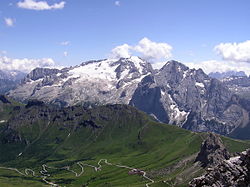
The Italians entered World War I on the side of Britain, France, and Russia against Germany and Austria-Hungary in late April 1915. Over the next three years, a series of bloody battles between the Italian army and the Austrians occurred in the mountainous region along the Isonzo River near the Italian-Austrian border. The weather conditions in the mountains were often a bigger hazard than the actual fighting. An Austrian officer once said “The mountains in winter are more dangerous than the Italians.” This was certainly true in mid-December 1916 when heavy snowfall in the Alps created conditions ripe for avalanches. That left hundreds of Austrian troops, who were stationed in a barracks near the Gran Poz summit of Mount Marmolada, in particular danger. The camp there was well-placed to protect it from Italian attack, but it was vulnerable because it was situated directly under a mountain of unstable snow. The approximately 200,000 tons of snow, rock, and ice plunged down the mountain directly  onto the barracks on December 13, killing 300 soldiers. About 200 soldiers were pulled to safety, but of the dead, only a few bodies were recovered.
onto the barracks on December 13, killing 300 soldiers. About 200 soldiers were pulled to safety, but of the dead, only a few bodies were recovered.
As heavy snow and high winds continued over the next week, incidents like the one at Marmolada continued to happen with disturbing frequency. Entire regiments were lost in an instant. Some of the bodies of victims weren’t found until spring. The best estimate of the losses incurred that fateful December is somewhere between 9,000 and 10,000 soldiers…a shocking number for a weapon of mass destruction that we wouldn’t have ever expected to be a weapon of war at all.

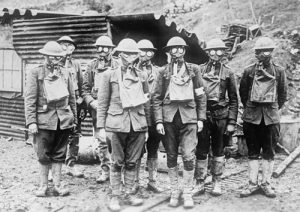 As nursing goes, I suppose you could say that World War I changed everything. War is an ugly business, and wounded men (and women these days) are just a part of the unavoidable side effects of it. As the upheaval of World War I changed the world, so the horrors of it, changed nursing.
As nursing goes, I suppose you could say that World War I changed everything. War is an ugly business, and wounded men (and women these days) are just a part of the unavoidable side effects of it. As the upheaval of World War I changed the world, so the horrors of it, changed nursing.
From 1914 to 1918, what was dubbed “the war to end all wars” in the innocence of the times, anyway…led to the mobilization of more than 70 million military personnel, including 60 million Europeans, making it one of the largest wars in history. As we know, it was hardly the war to end all wars, but it did change many of the things we had come to expect war to be. World War I was one of the deadliest conflicts in history. The death toll is staggering…estimated nine million combatants and seven million civilian deaths, as a direct result of the war. To add to that total, came the resulting genocides, as well as the 1918 influenza pandemic, which caused another 50 to 100 million deaths worldwide.
Now, just imagine being a nurse in those days. Of course, medical tents and hospitals were close to the perimeter of the fighting, to care for hurt soldiers quickly. This assured that the World War I nurses were witness to the conflict firsthand. I seriously doubt if any of them walked away from the war with less PTSD than the soldiers did. Many of them wrote about their involvement in diaries and letters that, similar to photographs from this time, offer insight into how they were personally impacted. The journals also include details about fighting, disease, and the hope that nurses and soldiers alike found in their darkest moments…if there could be any hope to be found.
It was in World War I that Germany introduced gas as a new form of aggression in 1915. It was in many ways the latest form of terrorism. To say that it was a different level of engagement seems an understatement. Gas devices became commonplace. They were worn anytime an air raid siren sounded, and some people wore them much of the time, as a precaution. The soldiers didn’t go anywhere without their gas mask. It was their life-line. Still, they were among the most feared elements of World War I.
“Sister Edith Appleton was a British nurse who served in France during World War I. She wrote about the soldiers stricken by gas and the adverse physical impacts they endured. The minimal immediate effects are tearing of the eyes, but subsequently, it causes build-up of fluid in the lungs, known as pulmonary edema, leading to death. It is estimated that as many as 85% of the 91,000 gas deaths in WWI were a result of phosgene or the related agent, diphosgene (trichloromethane chloroformate).”
Margaret Trevenen Arnold, a volunteer British Red Cross nurse in France in 1915 kept a diary of her time at Le Tréport and described “groans, and moans, and shouts, and half-dazed mutterings, and men with trephined heads suddenly sitting bolt upright… It was awful, and I really know now what [conflict] means.” These serious head injuries would most likely cause permanent brain damage for these men…if they survived at all.
Some hospital tents were eerily quiet, because the men in them were too sick to make a sound. Bandages were changed as often as every two hours, in an effort to ward off infection, and tourniquets to stop the bleeding until the soldier could be sent to surgery. Most of these field “hospitals” faced the same serious conditions…a lack of clean water and sterile surroundings. The nurses had to make due with what they had…and that often wasn’t much. Sometimes the lack of medicine became a major issue, especially when it came to anesthesia. Sometimes, the soldier had to simply force himself to remain calm, and steel himself to the inevitable pain of the surgery. These men had to place their faith in the doctors and nurses who cared for them, and they had not had time to even prepare for the need for surgery…let alone without anesthesia.
“Violet Gosset served on the Western Front from 1915 to 1919. While working at a hospital in Boulogne, France, Gosset kept notes about her experiences. She described a lack of supplies, overcrowded conditions, and scrapes that often resulted from a lack of adequate protection.”
“Helen Dare Boylston, an American nurse who served in France with the Harvard Unit medical team, had patients that spanned a wide range of age demographics. Some of the soldiers were just teenagers (“boys”), while others were in their 20s. However, Boylston recalled at least one soldier in his 60s (she called him “Dad”). Boylston saw the number of men in her care rise significantly in March 1918. At this time, she was sent…with two other nurses…to care for 500 soldiers. Boylston and her fellow nurses, including one named Ruth, quickly adapted to their conditions.”
Trench warfare was a shock to most of the soldiers. Still, most soldiers remained in good spirits. A part of nursing that might be considered a little different in the field hospitals is that the nurses are “in charge of” morale to a great degree. whether the men had Trench Foot, were sick, or wounded, they needed to have someone to lift their spirits. Who would have ever thought of nurses as morale boosters, but it was so.
Flu was widespread during World War I, even before the pandemic of 1918. After the pandemic began, things became critical. Now, nurses had to contend with treatment and prevention, in addition to other issues. One problem is that soldiers who ended up in medical tents and hospitals were often covered in mud, and flies frequently buzzed around them. Keeping germs at bay was next to impossible.
“Nurse Helen Dare Boylston was a keen observer of how soldiers reacted when they returned from the front, especially when they interacted with female nurses. She commented on the “fascinating game” of casual 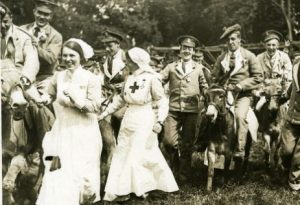
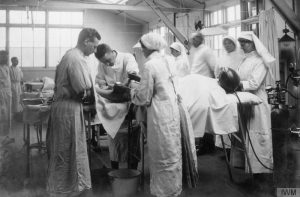 romance that commonly played out in the midst of conflict-related stress.” This was probably one of the most unusual phenomena, because nurses are told not to get emotionally involved, and yet here it was exactly what was needed. Nursing has changed over the years, but never has it been so evident as in World War I. It was as if nurses were making it up as they went along…and maybe they were.
romance that commonly played out in the midst of conflict-related stress.” This was probably one of the most unusual phenomena, because nurses are told not to get emotionally involved, and yet here it was exactly what was needed. Nursing has changed over the years, but never has it been so evident as in World War I. It was as if nurses were making it up as they went along…and maybe they were.
 These days, it seems we are all aware of what an emu is, probably due to the Liberty Mutual commercials that are out there, but in 1932 Australia, these were a nuisance bird. They were everywhere and they were not popular. In fact, they were running amok in the Campion district of Western Australia, and the public was very concerned. They had made several attempts to curb the growth of the emu population, including the Australian soldiers being armed with Lewis guns…leading the media to adopt the name “Emu War” when referring to the incident. While a number of the birds were killed, the emu population persisted and continued to cause crop destruction.
These days, it seems we are all aware of what an emu is, probably due to the Liberty Mutual commercials that are out there, but in 1932 Australia, these were a nuisance bird. They were everywhere and they were not popular. In fact, they were running amok in the Campion district of Western Australia, and the public was very concerned. They had made several attempts to curb the growth of the emu population, including the Australian soldiers being armed with Lewis guns…leading the media to adopt the name “Emu War” when referring to the incident. While a number of the birds were killed, the emu population persisted and continued to cause crop destruction.
After World War I ended, the Australian government gave land to large numbers of ex-soldiers from Australia and the UK. The purpose of the gift was to take up farming within Western Australia, often in areas that had been counterproductive. When the Great Depression hit in 1929, these farmers were encouraged to increase their wheat crops. The government promised assistance in the form of subsidies, but later failed to deliver. In spite of the recommendations and the promised subsidies, wheat prices continued to fall, and by October 1932 matters were becoming critical, with the farmers preparing to harvest the season’s crops and threatening to refuse to deliver the wheat.
To make matters, the area was hit with the arrival of as many as 20,000 emus. This is apparently an annual event as the emus regularly migrate after their breeding season, heading to the coast from the inland regions. With the cleared land and additional water supplies being made available for livestock by the Western Australian farmers, the emus decided that the farmlands were a good, and closer habitat, and they began to foray into farm territory, especially in the marginal farming land around Chandler and Walgoolan. The emus began to eat and spoil the crops. In addition, they left large gaps in fences where rabbits could enter and cause further destruction.
When the farmers relayed their concerns about the birds ravaging their crops, and a group of the ex-soldiers were sent to meet with the Minister of Defense, Sir George Pearce. Something had to be done. Having served in World War I, the soldiers-turned-settlers were well aware of the effectiveness of machine guns, and they requested their deployment to fight this new enemy. The minister readily agreed, although with conditions attached: the guns were to be used by military personnel, troop transport was to be financed by the Western Australian government, and the farmers would provide food, accommodation, and payment for the ammunition. The farmers agreed and Pearce also supported the deployment on the grounds that the birds would make good target practice, while some in the government viewed the operation as a way of being seen to be helping the Western Australian farmers, as a way of staving off the secession movement that was brewing.
Sir George Pearce, who was later referred to in Parliament, as the “Minister of the Emu War” by Senator James Dunn, ordered the army to selectively thin the nuisance emu population…by large numbers. The “war” was scheduled to begin in October 1932, under the command of Major G P W Meredith of the Seventh Heavy Battery of the Royal Australian Artillery. Meredith was supposed to use troops armed with two Lewis guns and 10,000 rounds of ammunition, but the operation was delayed by a period of rainfall that caused the emus to scatter over a wider area. The rain finally stopped by November 2, 1932, and the troops were quickly deployed with orders to assist the farmers and, according to a newspaper account, to collect 100 emu skins so that their feathers could be used to make hats for light horsemen. On November 2nd, the men travelled to Campion, where some 50 emus were sighted. Unfortunately, when they got there, the birds were out of range of the guns. The local settlers attempted to herd the emus into an ambush, but the birds split into small groups and ran so that they were difficult to target. Nevertheless, while the first attack from the machine guns was ineffective due to the distance from the targets, a second round of gunfire was able to kill “a number” of birds. Later the same day, a small flock was encountered, and “perhaps a dozen” birds were killed.
The next significant event was on November 4th, when Meredith established an ambush near a local dam. More than 1,000 emus were spotted heading towards their position. This time the gunners waited until the birds were in close proximity before opening fire. The gun jammed after only twelve birds were killed and the rest scattered before any more could be shot. No more birds were sighted that day, so the decision was made to move further south, where the birds were “reported to be fairly tame.” The group had only limited success in spite of Meredith’s efforts. As the pursuit continued, it became apparent that “each pack seemed to have its own leader now…a big black-plumed bird which stands fully six feet high and keeps watch while his mates carry out their work of destruction and warns them of our approach.” In desperation, Meredith even went so far as to mount one of the guns on a truck. He was still ineffective, as the truck was unable to gain on the birds, and the ride was so rough that the gunner was unable to fire any shots, even if they had been able to get close. By November 8th, six days after the first attack, 2,500 rounds of ammunition had been fired. The number of birds killed is uncertain. One account estimates that it was 50 birds, but other accounts range from 200 to 500, the latter figure being provided by the settlers. Meredith’s official reported that there were no casualties among the men.
Summarizing the operation, ornithologist Dominic Serventy commented, “The machine-gunners’ dreams of point blank fire into serried masses of Emus were soon dissipated. The Emu command had evidently ordered guerrilla tactics, and its unwieldy army soon split up into innumerable small units that made use of the military equipment uneconomic. A crestfallen field force therefore withdrew from the combat area after about a month. On 8 November, members in the Australian House of Representatives discussed the operation. Following the negative coverage of the events in the local media, that included claims that “only a few” emus had died, Pearce withdrew the military personnel and the guns on 8 November.”
After the “Emu War” was over, Meredith compared the emus to Zulus and commented on the striking maneuverability of the emus, even while badly wounded. After the withdrawal of the military, the emu attacks on crops continued. Farmers again asked for support, citing the hot weather and drought that brought emus invading farms in the thousands. James Mitchell, the Premier of Western Australia lent his strong support to renewal of the military assistance. At the same time, a report from the Base Commander was issued that indicated 300 emus had been killed in the initial operation.
The killing continued periodically, with similar results. The Emu was just too fast, too aware, or too “lucky,” to be caught or killed. By December 1932, word of the Emu War had spread, reaching the United Kingdom.  Conservationists protested the cull as “extermination of the rare emu”. Dominic Serventy and Hubert Whittell, the eminent Australian ornithologists, described the “war” as “an attempt at the mass destruction of the birds”. Throughout 1930 and onward, the farmers tried exclusion barrier fencing as a means of keeping emus out of agricultural areas (in addition to other vermin, such as dingoes and rabbits). In November 1950, Hugh Leslie raised the issues of emus in federal parliament and urged Army Minister Josiah Francis to release a quantity of .303 ammunition from the army for the use of farmers. The minister approved the release of 500,000 rounds of ammunition. The emu continues to thrive today.
Conservationists protested the cull as “extermination of the rare emu”. Dominic Serventy and Hubert Whittell, the eminent Australian ornithologists, described the “war” as “an attempt at the mass destruction of the birds”. Throughout 1930 and onward, the farmers tried exclusion barrier fencing as a means of keeping emus out of agricultural areas (in addition to other vermin, such as dingoes and rabbits). In November 1950, Hugh Leslie raised the issues of emus in federal parliament and urged Army Minister Josiah Francis to release a quantity of .303 ammunition from the army for the use of farmers. The minister approved the release of 500,000 rounds of ammunition. The emu continues to thrive today.
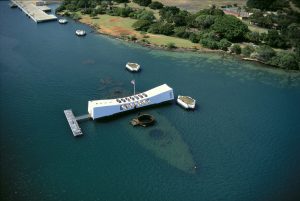 Probably the most notable memorials of the December 7, 1941 attack on Pearl Harbor, is the Arizona Memorial, which floats atop the sunken ship USS Arizona, which sank during that attack, taking with it 1,177 men. In all, the Japanese attack on Pearl Harbor, took the lives of 1998 navy personnel, 109 Marines, 233 army personnel and 48 civilians that were killed in that bombing which resulted in 2,402 soldiers killed and 1,282 military personnel and civilians wounded. Over half of the fatalities of that dreadful day occurred on the USS Arizona.
Probably the most notable memorials of the December 7, 1941 attack on Pearl Harbor, is the Arizona Memorial, which floats atop the sunken ship USS Arizona, which sank during that attack, taking with it 1,177 men. In all, the Japanese attack on Pearl Harbor, took the lives of 1998 navy personnel, 109 Marines, 233 army personnel and 48 civilians that were killed in that bombing which resulted in 2,402 soldiers killed and 1,282 military personnel and civilians wounded. Over half of the fatalities of that dreadful day occurred on the USS Arizona.
The USS Arizona had one more situation that would make it unique…in a tragic way. There were 38 sets of brother stationed on the USS Arizona. The brothers totaled 79 men. Of these 79 brothers, 63 lost their lives that day. There were three sets of three brothers: the Beckers, the Dohertys, and the Murdocks. Only one of each of the sets of three survived. Of the 38 sets of brothers on the USS Arizona, 23 complete sets were lost. There was also a father/son set on the USS Arizona…both of whom were killed in the attack. This is in no way to say that any of the other people killed in the Pearl Harbor attack of December 7, 1941 were less important that these brothers or the father and son set, because they weren’t. Every person that served when out nation was brutally attacked that day, gave their lives for their country. The brothers serving was unusual, in that the military tries not to place siblings together,  lest they both be killed, but these men requested this. They liked having their brother there with them. I can understand that. Long months away from family can be very lonely.
lest they both be killed, but these men requested this. They liked having their brother there with them. I can understand that. Long months away from family can be very lonely.
The explosion and subsequent fires on the USS Arizona killed 1,177 sailors and marines instantly. The entire front portion of the ship was destroyed, because the fire burned everything in its path. To make matters worse, the fires continued for 2½ days, causing the bodies that were there to be cremated before anyone could located and removed. Out of a crew of 1,511 men on the USS Arizona, only 334 survived. Of the dead, only 107 were positively identified, due to the immense fire. The remaining 1,070 casualties fell into three categories: (1) Bodies that were never found; (2) Bodies that were removed from the ship during salvage operations and were severely dismembered or partially cremated that identification was impossible. DNA testing was unheard of in 1941. These bodies were placed in temporary mass graves, and later moved and reburied and marked as unknowns, at the National Memorial Cemetery of the Pacific (Punchbowl) in 1949; and (3) Bodies located in the aft (rear) portion of the ship. These remains could have been recovered, but were left in the ship due to their unidentifiable condition. The injuries to these bodies indicated that most of these crew members died from the concussion from the massive explosion.
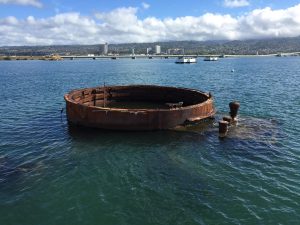 Everyone of the people who lost their lives on December 7, 1941, at Pearl Harbor, were heroes. Their families were left to mourn their loss, mostly without the closure that can be found when there is a body to bury. The horrific attack marked the inevitable entrance of the United States into World War II, and if the Japanese thought they could beat the United States with this sneak attack, they soon found out just how wrong they were. They had awakened the “sleeping giant” and they would be sorry they did. Today we honor all those who dies at Pearl Harbor, but also, all who survived and went forward to avenge their fallen comrades. We will never forget their sacrifice. We are forever grateful.
Everyone of the people who lost their lives on December 7, 1941, at Pearl Harbor, were heroes. Their families were left to mourn their loss, mostly without the closure that can be found when there is a body to bury. The horrific attack marked the inevitable entrance of the United States into World War II, and if the Japanese thought they could beat the United States with this sneak attack, they soon found out just how wrong they were. They had awakened the “sleeping giant” and they would be sorry they did. Today we honor all those who dies at Pearl Harbor, but also, all who survived and went forward to avenge their fallen comrades. We will never forget their sacrifice. We are forever grateful.
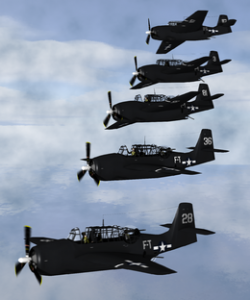 The morning of December 6, 1945 found the United States Navy desperately searching the area known as the Bermuda Triangle for a group of planes. Flight 19 was a routine navigation and combat training exercise in TBM-type aircraft. The group had set out on December 5, 1945 at 2:10pm from Fort Lauderdale Naval Air Station. Their training would take them due east toward the Bermuda Triangle. Much mystery has surrounded the Bermuda Triangle, with ship and planes alike reporting navigation problems in the area, and some disappearing forever. I don’t exactly know what I believe about the Bermuda Triangle, but it is my opinion that there is a logical explanation for the events that have taken place there. Still, many of the lost planes and ship were never heard from again, and never located, so I don’t know.
The morning of December 6, 1945 found the United States Navy desperately searching the area known as the Bermuda Triangle for a group of planes. Flight 19 was a routine navigation and combat training exercise in TBM-type aircraft. The group had set out on December 5, 1945 at 2:10pm from Fort Lauderdale Naval Air Station. Their training would take them due east toward the Bermuda Triangle. Much mystery has surrounded the Bermuda Triangle, with ship and planes alike reporting navigation problems in the area, and some disappearing forever. I don’t exactly know what I believe about the Bermuda Triangle, but it is my opinion that there is a logical explanation for the events that have taken place there. Still, many of the lost planes and ship were never heard from again, and never located, so I don’t know.
Flight 19 consisted of five TBM Avenger torpedo bombers, all of which disappeared on December 5, 1945, during the overwater navigation training flight from Naval Air Station Fort Lauderdale, Florida. In all, 14 airmen on the flight were lost, as were all 13 crew members of a PBM Mariner flying boat that was searching for the planes. It is assumed by professional investigators to have exploded in mid-air. Navy investigators could not determine the cause of the loss of Flight 19, but said the aircraft may have become disoriented and ditched in rough seas after running out of fuel. While that is logical, no debris was ever found, nor were the planes ever located, although some think they know where the planes are these days.
The assignment was called “Navigation problem No. 1,” which seems ironic in retrospect. The name was given before the planes experienced problems. “Navigation problem No. 1” was a combination of bombing and navigation, which other flights had completed or were scheduled to undertake that day. The leader for Flight 19 was United States Navy Lieutenant Charles Carroll Taylor who had about 2,500 flying hours, mostly in aircraft of this type, while his trainee pilots had 300 total, and 60 flight hours in the Avenger. Taylor had recently arrived from Naval Air Station Miami where he had also been a VTB instructor. The student pilots had recently completed other training missions in the area where the flight was to take place. They were United States Marine Captains Edward Joseph Powers and George William Stivers, United States Marine Second Lieutenant Forrest James Gerber and United States Navy Ensign Joseph Tipton Bossi. The callsigns for the flight started with ‘Fox Tair,’ or FT and the plane number.
Each aircraft was fully fueled, and during pre-flight checks it was discovered they were all missing clocks. Navigation of the route was intended to teach dead reckoning principles, which involved calculating among other things elapsed time. I suppose that if trained, a person could do that, but I don’t think I could. The apparent lack of timekeeping equipment was not a cause for concern as it was assumed each man had his own watch. Takeoff was scheduled for 13:45 local military time, but the late arrival of Taylor delayed departure until 14:10. The weather at NAS Fort Lauderdale was described as “favorable, sea state moderate to rough.” Taylor was supervising the mission, and a trainee pilot had the role of leader out front.

This exercise was called “Naval Air Station, Fort Lauderdale, Florida, navigation problem No. 1,” and involved three different legs. There should have actually been four flown. After take off, the planes flew on heading 091°, which is almost due east for 56 nautical miles, until they reached Hen and Chickens Shoals where low level bombing practice was carried out. The flight was to continue on that heading for another 67 nautical miles before turning onto a course of 346° for 73 nautical miles, in the process over-flying Grand Bahama island. The next scheduled turn was to a heading of 241° to fly 120 nautical miles at the end of which the exercise was completed and the Avengers turned left to return to NAS Fort Lauderdale.
Radio conversations between the pilots were overheard by base and other aircraft in the area. The practice bombing operation was carried out because at about 15:00 a pilot requested and was given permission to drop his last bomb. Forty minutes later thins began to go wrong, when another flight instructor, Lieutenant Robert F. Cox in FT-74, forming up with his group of students for the same mission, received an unidentified transmission. An unidentified crew member asked Powers, one of the students, for his compass reading. Powers replied: “I don’t know where we are. We must have got lost after that last turn.” Cox then transmitted; “This is FT-74, plane or boat calling ‘Powers’ please identify yourself so someone can help you.” The response after a few moments was a request from the others in the flight for suggestions. FT-74 tried again and a man identified as FT-28 (Taylor) came on. “FT-28, this is FT-74, what is your trouble?” “Both of my compasses are out”, Taylor replied, “and I am trying to find Fort Lauderdale, Florida. I am over land but it’s broken. I am sure I’m in the Keys but I don’t know how far down and I don’t know how to get to Fort Lauderdale.” As the weather deteriorated, radio contact became intermittent, and it was believed that the five aircraft were actually by that time more than 200 nautical miles out to sea east of the Florida peninsula. Taylor radioed “We’ll fly 270 degrees west until landfall or running out of gas.” The last known location of Flight 19 was 75 miles northeast of Cocoa, Florida.
Had Flight 19 actually been where Taylor believed it to be, landfall with the Florida coastline would have been reached in a matter of 10 to 20 minutes or less, depending on how far down they were. However, a later reconstruction of the incident showed that the islands visible to Taylor were probably the Bahamas, well northeast of the Keys, and that Flight 19 was exactly where it should have been. The board of investigation found that because of his belief that he was on a base course toward Florida, Taylor actually guided the flight further northeast and out to sea. The only problem I have with that idea is that they never found any debris, and never located the planes. Had they crashed into the ocean, they should have shown up somewhere.
In 1986, the wreckage of an Avenger was found off the Florida coast during the search for the wreckage of the Space Shuttle Challenger. Aviation archaeologist Jon Myhre raised the wreck from the ocean floor in 1990. He was convinced it was one of the missing planes, but positive identification could not be made. In 1991, the wreckage of five Avengers was discovered off the coast of Florida, but engine serial numbers revealed they 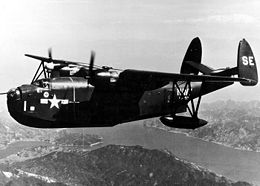 were not Flight 19. They had crashed on five different days all within 1.5 miles of each other. Records revealed that the various discovered aircraft, including the group of five, were declared either unfit for maintenance/repair or obsolete, and were simply disposed of at sea. Records also showed training accidents between 1942 and 1945 accounted for the loss of 95 aviation personnel from NAS Fort Lauderdale. In 1992, another expedition located scattered debris on the ocean floor, but nothing could be identified. In the last decade, searchers have been expanding their area to include farther east, into the Atlantic Ocean, but the remains of Flight 19 have still never been confirmed found.
were not Flight 19. They had crashed on five different days all within 1.5 miles of each other. Records revealed that the various discovered aircraft, including the group of five, were declared either unfit for maintenance/repair or obsolete, and were simply disposed of at sea. Records also showed training accidents between 1942 and 1945 accounted for the loss of 95 aviation personnel from NAS Fort Lauderdale. In 1992, another expedition located scattered debris on the ocean floor, but nothing could be identified. In the last decade, searchers have been expanding their area to include farther east, into the Atlantic Ocean, but the remains of Flight 19 have still never been confirmed found.
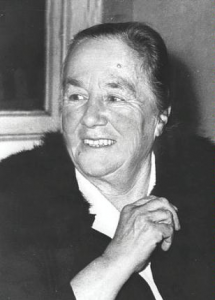 When Hitler began his reign of terror on the Jewish people, along with several other groups that he considered undesirables…the groups who were not of the “Aryan Race,” he proceeded to do unspeakable things to these poor people who could not fight back because they had no weapons. They were a peace-loving people who were just trying to get along with those around them, and those in power. Unfortunately, Hitler didn’t care if they were peace-loving, if they wanted to get along, or be cooperative. Their only crime was that they were not of the “Aryan Race.” For anyone who doesn’t really understand the concept of Aryan, it is this: “The Aryan race is a historical race concept which emerged in the period of the late 19th century and mid-20th century to describe people of Indo-European heritage as a racial grouping.”
When Hitler began his reign of terror on the Jewish people, along with several other groups that he considered undesirables…the groups who were not of the “Aryan Race,” he proceeded to do unspeakable things to these poor people who could not fight back because they had no weapons. They were a peace-loving people who were just trying to get along with those around them, and those in power. Unfortunately, Hitler didn’t care if they were peace-loving, if they wanted to get along, or be cooperative. Their only crime was that they were not of the “Aryan Race.” For anyone who doesn’t really understand the concept of Aryan, it is this: “The Aryan race is a historical race concept which emerged in the period of the late 19th century and mid-20th century to describe people of Indo-European heritage as a racial grouping.”
When Hitler, invaded Poland, he quickly began to turn people against the Jewish people. These people had been living as a part of a community, making an important contribution to Polish society. Hitler began by polluting the minds of the young people first, and then the older people against the Jewish people, saying that they were thieves, and that everything they owned rightfully belonged to the “Aryan” people. Many of the people bought into Hitler’s lies and hatred, but there were those who did not. The problem was that even those who did not agree to help the Jews, had to be careful, because if they didn’t turn in those who helped, it was considered harboring criminals. If they were caught helping the Jews, they could be sent to the work camps or executed.
Since the German invasion of Poland in 1939, the Jewish population had been either forced into ghettos, transported to concentration and labor camps, or murdered. Jewish homes and shops were confiscated and synagogues were burned to the ground. By 1942, things were getting really tough in Warsaw, but a group of Polish Christians refused to stand by and do nothing. So, they put their own lives at risk when they set up the Council for the Assistance of the Jews. The group was led by two women, Zofia Kossak and Wanda Filipowicz. Word about the Jews’ fate finally leaked out in June of 1942, when a Warsaw underground newspaper, the Liberty Brigade, made public the news that tens of thousands of Jews were being gassed at Chelmno, a death camp in Poland. It had been almost seven months since the extermination of prisoners had begun.
At first, people didn’t believe what they heard about the “Final Solution,” which was the mass extermination of European Jewry and the growing network of extermination camps in Poland. Soon, it was difficult to deny. Nevertheless, little was done to stop it. Angry speeches from politicians, followed by threats of postwar reprisals, were heard in places outside Poland. Within Poland, non-Jewish Poles were themselves often the objects of persecution and forced labor at the hands of their Nazi occupiers. Because they were Slavs, they too were considered “inferior” to the Aryan Germans, and therefore, only good as servants and slaves…according to the Nazis anyway. Zofia Kossak and Wanda Filipowicz didn’t care that they could lose their lives, what was going on, was wrong and they could not stand by and do nothing. These two Polish Christians were determined to do what they could to protect their Jewish neighbors.
History says that both women died in 1968, but it is unclear what caused Kossak and Filipowicz’s deaths. It is also unclear whether their mission was to protect the Polish Jews was successful. No matter what the outcome of their plan was, they did the right thing. They saw something that wasn’t right, and they tried to do something to correct the situation. Kossak and Filipowicz were not alone in their struggle to help either. Just two days after the Council was established, the SS, Hitler’s “political” terror police force, rounded up 23 men, 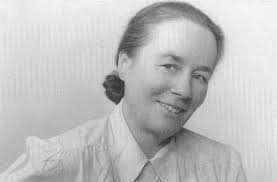 women, and children, and locked some in a cottage and some in a barn. Then they burned them alive. Their crime: suspicion of harboring Jews. They were not convicted or tried, they were just murdered.
women, and children, and locked some in a cottage and some in a barn. Then they burned them alive. Their crime: suspicion of harboring Jews. They were not convicted or tried, they were just murdered.
The Nazi death machine proved overwhelming, even with the bravery of some Polish Christians, and Jewish resistance fighters within the Warsaw ghetto, who rebelled in 1943. Some of the Polish Jews found refuge among their Christian neighbors, in an attempt to elude the SS. Poland became the killing ground for not only Poland’s Jewish citizens, but much of Europe’s as well…approximately 4.5 million Jews were killed in Poland’s death and labor camps by the end of World War II.
 Alvin Kelly was born in Manhattan on May 11, 1893. His story began in a tragic way, because his father died before his birth and his mother died in childbirth with him. Kelly, now a newborn orphan, was raised in orphanages and passed around to various relatives. When Kelly turned 7, he started climbing onto poles and a few years later, he scaled the outside of buildings in his neighborhood…and by the way, his name wasn’t Alvin back then. It was Aloysius Anthony Kelly. He became Alvin when he ran away to go to work on a cargo ship. He was just 13 years old, and he changed his name to Alvin…probably to remain anonymous.
Alvin Kelly was born in Manhattan on May 11, 1893. His story began in a tragic way, because his father died before his birth and his mother died in childbirth with him. Kelly, now a newborn orphan, was raised in orphanages and passed around to various relatives. When Kelly turned 7, he started climbing onto poles and a few years later, he scaled the outside of buildings in his neighborhood…and by the way, his name wasn’t Alvin back then. It was Aloysius Anthony Kelly. He became Alvin when he ran away to go to work on a cargo ship. He was just 13 years old, and he changed his name to Alvin…probably to remain anonymous.
It wasn’t Kelly’s life as a runaway that made him unique, however, because runaways have existed for centuries. His childhood trick of climbing on poles stuck with him for the rest of his life. In fact, during the 1920s and 1930s, Kelly earned a name for himself…and a certain degree of notoriety…by sitting atop flag poles and other odd elevated perches for extended periods of time. I can’t imagine the purpose of such an act, and it’s not the most conventional way to fame, but for Alvin ‘Shipwreck’ Kelly it worked. Shipwreck Kelly, as he became known, is credited with starting the flagpole sitting fad, which, strangely, became popular in the Roaring Twenties, and he even earned a spot in the World Record Book for his sitting ability. I suppose an actor, comedian, magician, and such, needed a gimmick or a nickname, so Kelly began to use the nickname ‘Shipwreck’ claiming that he had survived the sinking of the Titanic. The story was proved to be untrue. Even then, Kelly claimed that he had many other close calls in his life. He said he had survived five shipwrecks, two plane crashes, three car accidents and one train derailment. In reality, Kelly most likely, acquired his nickname in the boxing ring. Not the greatest boxer, critics claimed he was often “adrift and ready to sink.”
As a teen and young man, Kelly hopped from job to job. His unusual ability to climb a pole and perch at the top did earn his work that he might not have otherwise been able to get. In addition to working at sea, he was a stunt pilot, movie double, steelworker, high diver, boxer, and a steeplejack. During World War I, Kelly was an ensign in the Naval Auxiliary Reserve, serving on the USS Edgar F. Luckenbach.
You might be wondering what started his Pole Sitting career. Well, like many a young man, Kelly was not one to back away from a dare. In 1924, he was dared by a friend to climb to the top of a flagpole in Philadelphia 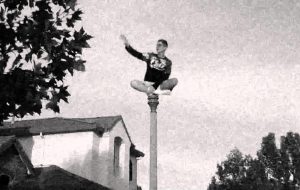 outside a local department store. Of course, Kelly jumped at the chance to prove himself. He quickly ascended the pole and perched himself on top. The stunt attracted a large crowd, many of whom then went inside to shop in the department store. The store manager asked Kelly to stay up there a while…it was good for business! Newspapers carried pictures of Kelly’s stunt, many daredevils began copying his stunt. A fad was born! Soon pole sitting was a popular trick and copycat sitters did it for laughs, on a dare, or to protest. Even though so many others were doing it now, Kelly, the original pole sitter, continued his stunts to the delight of onlookers and journalists. Everyone knew he was the original, and the others were merely copycats.
outside a local department store. Of course, Kelly jumped at the chance to prove himself. He quickly ascended the pole and perched himself on top. The stunt attracted a large crowd, many of whom then went inside to shop in the department store. The store manager asked Kelly to stay up there a while…it was good for business! Newspapers carried pictures of Kelly’s stunt, many daredevils began copying his stunt. A fad was born! Soon pole sitting was a popular trick and copycat sitters did it for laughs, on a dare, or to protest. Even though so many others were doing it now, Kelly, the original pole sitter, continued his stunts to the delight of onlookers and journalists. Everyone knew he was the original, and the others were merely copycats.
Never content, Kelly continued to look for ways to outdo his latest tricks. In 1926 in Saint Louis, he stayed perched atop a pole for seven days and one hour. The next year, in June of 1927 in Newark, New Jersey, he extended his record to twelve days. Next, it was a 23 day sit on a flagpole in Carlin’s Park in Baltimore in 1929. His final record was set in 1930 when he stayed on a flagpole on Atlantic City’s Steel Pier for 49 days and one hour. I don’t know about you, but I can’t begin to imagine such extended days sitting on a flagpole. Nevertheless, for Kelly, it seemed to be a normal part of his daily routine. Newspapers of the 1920s loved to feature photographs of Kelly “sitting high in the air, especially ones of him doing everyday things, like shaving or reading a newspaper or brushing his teeth. During his sits, Kelly rarely ate, sustaining himself on coffee and cigarettes. Although he used a leg tether as a safeguard against falling, He learned to sleep sitting upright and he explained that he slept with his thumbs stuck in holes in the pole. If he started to lean one way or the other in his sleep, the pain in his thumbs would wake him in time for him to right himself.”
Kelly toured across the country during the peak of his fame, and charged admission for people to see him sitting on a flagpole. I would find watching someone sit on a pole would be boring, but people did. He once estimated that he spent 20,613 hours sitting on flag poles in his lifetime, including about 1,400 hours in  pouring down rain and 210 hours in sub-freezing temperatures. He was often hired to do publicity stunts because business owners knew he could draw a crowd. For example, on October 13, 1939, Kelly was hired to promote National Donut Dunking Week by sitting on a pole in Manhattan and eating 13 donuts dipped in coffee. I wonder how much they paid him for that stunt.
pouring down rain and 210 hours in sub-freezing temperatures. He was often hired to do publicity stunts because business owners knew he could draw a crowd. For example, on October 13, 1939, Kelly was hired to promote National Donut Dunking Week by sitting on a pole in Manhattan and eating 13 donuts dipped in coffee. I wonder how much they paid him for that stunt.
As the Great Depression of the 1930s progressed, people became less interested in Kelly’s tricks…and less tolerant. In 1935, he attempted to break his own record again, but the Bronx police said he was creating a public nuisance. The police threatened to chop down his pole, if he didn’t come down and when he did, he was promptly arrested. His last attempt at pole sitting was in Orange, Texas, in 1952. That day, while sitting on the pole, Kelly suffered two heart attacks and was forced to come down. He announced his retirement from pole sitting and died a week later.
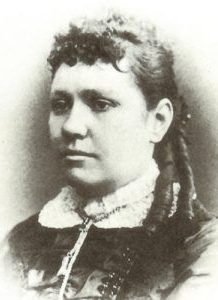 Alice Ivers Tubbs was born in Devonshire, England on February 17, 1851. She was the daughter of a conservative schoolmaster. While Alice was still a small girl, she moved with her family to the United States. The family first settled in Virginia, where Alice attended an elite boarding school for women. When she was a teenager, the family moved with the silver rush to Leadville, Colorado. As a young girl, Alice was raised to be a well-bred young lady, so few people would ever expect her to be known as “Poker Alice.” Nevertheless, marriage can change a person. While living in Leadville, Alice met a mining engineer named Frank Duffield, whom she married when she was just 20 years old. In the mining camps, gambling’s was quite common, and Frank was an enthusiastic player. He enjoyed visiting the gambling halls in Leadville and Alice naturally went along with him, rather than staying home alone. Alice stood quietly and watch her husband play…at first, but Alice was smart, and she picked up the game of poker easily. Soon she was sitting in on the games, and she was winning. Alice’s marriage to Frank Duffield was short-lived. Duffield, who worked in the mines as part of his job, was killed in an explosion. Needing to make a living, Alice, who was well educated, could have taught school, but even with 35,000 residents in Leadville, there was no school. There were also few jobs available for women, and those there were, did not appeal to Alice, so she decided to make a living gambling. Though Alice preferred the game of poker, she also learned to deal and play Faro. Very soon, she was in high demand…as a player and a dealer. Alice was a petite 5 foot 4 inch beauty, with blue eyes and thick brown hair. She was very rare in that she was a “lady” in a gambling hall…and not of the “soiled dove” variety. And Alice loved the latest fashions, she was a sight for the sore eyes of many a miner. Every time Alice had a big win, she began to take trips to New York City to buy the latest fashions.
Alice Ivers Tubbs was born in Devonshire, England on February 17, 1851. She was the daughter of a conservative schoolmaster. While Alice was still a small girl, she moved with her family to the United States. The family first settled in Virginia, where Alice attended an elite boarding school for women. When she was a teenager, the family moved with the silver rush to Leadville, Colorado. As a young girl, Alice was raised to be a well-bred young lady, so few people would ever expect her to be known as “Poker Alice.” Nevertheless, marriage can change a person. While living in Leadville, Alice met a mining engineer named Frank Duffield, whom she married when she was just 20 years old. In the mining camps, gambling’s was quite common, and Frank was an enthusiastic player. He enjoyed visiting the gambling halls in Leadville and Alice naturally went along with him, rather than staying home alone. Alice stood quietly and watch her husband play…at first, but Alice was smart, and she picked up the game of poker easily. Soon she was sitting in on the games, and she was winning. Alice’s marriage to Frank Duffield was short-lived. Duffield, who worked in the mines as part of his job, was killed in an explosion. Needing to make a living, Alice, who was well educated, could have taught school, but even with 35,000 residents in Leadville, there was no school. There were also few jobs available for women, and those there were, did not appeal to Alice, so she decided to make a living gambling. Though Alice preferred the game of poker, she also learned to deal and play Faro. Very soon, she was in high demand…as a player and a dealer. Alice was a petite 5 foot 4 inch beauty, with blue eyes and thick brown hair. She was very rare in that she was a “lady” in a gambling hall…and not of the “soiled dove” variety. And Alice loved the latest fashions, she was a sight for the sore eyes of many a miner. Every time Alice had a big win, she began to take trips to New York City to buy the latest fashions.
Due to her traveling from one mining camp to another to play poker, Alice soon acquired the nickname “Poker Alice.” In addition to playing the game, she often worked as a dealer, in cities all over Colorado including Alamosa, Central City, Georgetown, and Trinidad. Later on, Alice began to puff on large black cigars, still wearing her fashionable frilly dresses. She, nevertheless, never gambled on Sundays because of her religious beliefs. Alice carried a .38 revolver and wasn’t afraid to use it. It was rather a necessity, due to her lifestyle. Alice soon left Colorado and made her way to Silver City, New Mexico, where she broke the bank at the Gold Dust Gambling House, winning some $6,000. The win was followed by a trip to New York City, to replenish her wardrobe of fashionable clothing. Afterward, she returned to Creede, Colorado. She went to work as a dealer in Bob Ford’s saloon…the man who had earlier killed Jesse James. Alice later moved to Deadwood, South Dakota around 1890. In Deadwood, she met a man named Warren G. Tubbs, who worked as a housepainter in Sturgis, but sidelined as a dealer and  gambler. Alice usually beat Tubbs at poker, but that didn’t bother him. He was taken with her and they began to see each other socially. Once a drunken miner threatened Tubbs with a knife, Alice pulled out her .38 and put a bullet into the miner’s arm. I’m sure that man thought the threat was Tubbs, but the man should have watched Alice in stead. Later, the couple married and had seven children…four sons and three daughters. Because Tubbs was a painter by trade, he, along with Alice’s gambling profits, supported the family. The family moved out of Deadwood, to homesteaded a ranch near Sturgis on the Moreau River. Finally, Alice found something she loved more than gambling…for the most part. She helped with the ranch and raised her children. Then, fate would again deal Alice a bad hand. Tubbs was diagnosed with tuberculosis. Alice refused to leave his side. She planned to nurse him back to health. Tubbs lost his fight, and died of pneumonia in the winter of 1910. Alice was determined to give him a proper burial, so she loaded him into a horse-drawn wagon to take his body to Sturgis. It is thought that she had to pawn her wedding ring to pay for the funeral and afterward, went to a gambling parlor to earn the money to get her ring back.
gambler. Alice usually beat Tubbs at poker, but that didn’t bother him. He was taken with her and they began to see each other socially. Once a drunken miner threatened Tubbs with a knife, Alice pulled out her .38 and put a bullet into the miner’s arm. I’m sure that man thought the threat was Tubbs, but the man should have watched Alice in stead. Later, the couple married and had seven children…four sons and three daughters. Because Tubbs was a painter by trade, he, along with Alice’s gambling profits, supported the family. The family moved out of Deadwood, to homesteaded a ranch near Sturgis on the Moreau River. Finally, Alice found something she loved more than gambling…for the most part. She helped with the ranch and raised her children. Then, fate would again deal Alice a bad hand. Tubbs was diagnosed with tuberculosis. Alice refused to leave his side. She planned to nurse him back to health. Tubbs lost his fight, and died of pneumonia in the winter of 1910. Alice was determined to give him a proper burial, so she loaded him into a horse-drawn wagon to take his body to Sturgis. It is thought that she had to pawn her wedding ring to pay for the funeral and afterward, went to a gambling parlor to earn the money to get her ring back.
For Alice, the time spent on the ranch were some of the happiest days of her life and that during those years, she didn’t miss the saloons and gambling halls. Alice liked the peace and quiet of the ranch. Still, she had to make a living, so after Tubbs’ death, she hired a man named George Huckert to take care of the homestead, and she moved to Sturgis to earn her way. Huckert quickly fell in love with Alice and proposed marriage to her several times. Alice didn’t really love him, but finally married him, saying flippantly, “I owed him so much in back wages; I figured it would be cheaper to marry him than pay him off. So I did.” Once again, the marriage would be short. Alice was widowed once again when Huckert died in 1913.
During the Prohibition years, Alice opened a saloon called “Poker’s Palace” between Sturgis and Fort Meade that provided not only gambling and liquor, but also “women” who serviced the customers. One night, a drunken soldier began a fight in the saloon. He was destroying the furniture, and causing a ruckus. Alice pulled her .38 and shot the man. While in jail awaiting trial, she calmly smoked cigars and read the Bible. She was acquitted on grounds of self-defense, but her saloon had been shut down. Now, in her 70s and with her beauty and fashionable gowns long gone, Alice struggled in her last years. She continued to gamble, but these days, she dressed in men’s clothing. Once in a while, she was featured at 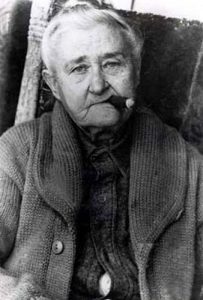 events like the Diamond Jubilee, in Omaha, Nebraska, as a true frontier character, where she was known to have said, “At my age, I suppose I should be knitting. But I would rather play poker with five or six ‘experts’ than eat.” She continued to run a “house” of ill-repute in Sturgis during her later years and was often arrested for drunkenness and keeping a disorderly house. Though she paid her fines, she continued to operate the business until she was finally arrested for repeated convictions of running a brothel and sentenced to prison. The governor took pity on Alice, who was then 75 years old, and pardoned her. At the age of 79, Alice underwent a gall bladder operation in Rapid City. Unfortunately, she died of complications on February 27, 1930. She was buried at Saint Aloysius Cemetery in Sturgis, South Dakota. In her lifetime, Alice claimed to have “won more than $250,000 at the gaming tables and never once cheated.” In fact, one of her favorite sayings was, “Praise the Lord and place your bets. I’ll take your money with no regrets.”
events like the Diamond Jubilee, in Omaha, Nebraska, as a true frontier character, where she was known to have said, “At my age, I suppose I should be knitting. But I would rather play poker with five or six ‘experts’ than eat.” She continued to run a “house” of ill-repute in Sturgis during her later years and was often arrested for drunkenness and keeping a disorderly house. Though she paid her fines, she continued to operate the business until she was finally arrested for repeated convictions of running a brothel and sentenced to prison. The governor took pity on Alice, who was then 75 years old, and pardoned her. At the age of 79, Alice underwent a gall bladder operation in Rapid City. Unfortunately, she died of complications on February 27, 1930. She was buried at Saint Aloysius Cemetery in Sturgis, South Dakota. In her lifetime, Alice claimed to have “won more than $250,000 at the gaming tables and never once cheated.” In fact, one of her favorite sayings was, “Praise the Lord and place your bets. I’ll take your money with no regrets.”
 When people think of Venice, Italy, they think of the canals and the boats. I think most of us think the city is pretty much streets of water, and buildings that somehow stand in the water…strong and immovable against the water. Venice is the center of the lagoon of Venice, which extends over a length of 25 miles around the city. While it seems like the city is covered in water, only 11% of the lagoon is permanently covered with water, while the rest of the lagoon is islands or mudflats and marshes (Laguna Morta). The water stays fresh because, seawater from the Adriatic flows into the lagoon through three large passages, Bocca di Lido, Bocca di Malamocco, and Bocca di Chioggia, twice daily. This process provides a natural water exchange. Still, 11% water can sure look like a lot, especially when every touristy picture we see involves the canals and gondolas. So, to think of a situation whereby a flood could become tragic in Venice, is a strange thought for anyone who doesn’t really know Venice…like me.
When people think of Venice, Italy, they think of the canals and the boats. I think most of us think the city is pretty much streets of water, and buildings that somehow stand in the water…strong and immovable against the water. Venice is the center of the lagoon of Venice, which extends over a length of 25 miles around the city. While it seems like the city is covered in water, only 11% of the lagoon is permanently covered with water, while the rest of the lagoon is islands or mudflats and marshes (Laguna Morta). The water stays fresh because, seawater from the Adriatic flows into the lagoon through three large passages, Bocca di Lido, Bocca di Malamocco, and Bocca di Chioggia, twice daily. This process provides a natural water exchange. Still, 11% water can sure look like a lot, especially when every touristy picture we see involves the canals and gondolas. So, to think of a situation whereby a flood could become tragic in Venice, is a strange thought for anyone who doesn’t really know Venice…like me.
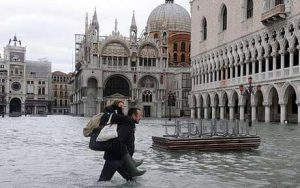
On December 1, 2008, Venice experienced the biggest flood in more than twenty years. The waters rose more than five feet above normal levels. As with any flood, many of Venice’s streets, including Saint Mark’s Square, were submerged. Venice has flooding for about two hundred days every year, and the Venetian authorities were working to complete an underwater dam by 2011. Unfortunately, that fact didn’t help the city in 2008. Even with unusually high tides because of the new moon, residents were not surprised to see the usual low-lying lanes under water. Nevertheless, this day was different. Pretty much the entire city was covered by the lagoon. People stayed inside to wait out the water, only going outside when they were sure the water was definitely going down. The townspeople went outside to take pictures and explore the current townscape…to see what was underwater now. They were quite surprised at the scene before them.
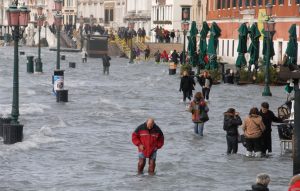
By mid-afternoon, the water had gone down to more normal levels, but all over the world, the papers made it seem like the whole city was sinking. The high tide would come again on December 2nd, but it was nothing like December 1st. Cleanup was still underway on December 2nd, of course, but most businesses were open again. I suppose that if your city spends it’s life in one stage of flood or another, this extra high tide was just something to be taken in stride. Yes, people were surprised at the higher than normal flood waters from the tide, but they weren’t panicked. It was just another day in the life of Venice.

 The ship, SS Daniel J. Morrell was a 603 foot Great Lakes freighter, first launched August 22, 1906. It was operated by Cambria Steamship Company. The freighter was used to carry bulk cargoes such as iron ore. SS Daniel J. Morrell was named for Daniel Johnson Morrell, a Republican member of the US House of Representatives from Pennsylvania. In 1855 he moved to Johnstown, Pennsylvania, and became general manager of the Cambria Iron Company, which was the greatest manufacturer of iron and steel in the United States until the Johnstown Flood. As a former general manager of Cambria Steamship Company…Morrell died August 20, 1885…naming the ship after him made sense.
The ship, SS Daniel J. Morrell was a 603 foot Great Lakes freighter, first launched August 22, 1906. It was operated by Cambria Steamship Company. The freighter was used to carry bulk cargoes such as iron ore. SS Daniel J. Morrell was named for Daniel Johnson Morrell, a Republican member of the US House of Representatives from Pennsylvania. In 1855 he moved to Johnstown, Pennsylvania, and became general manager of the Cambria Iron Company, which was the greatest manufacturer of iron and steel in the United States until the Johnstown Flood. As a former general manager of Cambria Steamship Company…Morrell died August 20, 1885…naming the ship after him made sense.
SS Daniel J. Morrell, along with her sister ship, SS Edward Y. Townsend were making the last run of the season. On November 29, 1966, they encountered a storm with winds exceeding 70 miles per hour and swells that topped the height of the ship, at 20 to 25 feet. Edward Y. Townsend decided to take shelter in the St. Clair River. That left Daniel J. Morrell alone on the waters north of Pointe Aux Barques, Michigan, heading for the protection of Thunder Bay. As the storm grew worse, and at 2:00pm, the Morrell began to break up, which forced the crew onto the deck. Many of the crew panicked and jumped to their deaths in the 34° Lake Huron waters. At 2:15pm, the ship’s hull broke and allowed water to pour in, and the remaining crewmen loaded into a raft on the bow of the vessel. While they waited for the ship to break up and the raft to be thrown into the lake, there were shouts that a ship had been spotted off the port bow. Unfortunately, moments later, it became clear that  the looming object was not another ship, but Daniel J. Morrell’s aft section, barreling towards them under the power of the ship’s engine. The ship broke apart, throwing the rafts into the water heading into the distance.
the looming object was not another ship, but Daniel J. Morrell’s aft section, barreling towards them under the power of the ship’s engine. The ship broke apart, throwing the rafts into the water heading into the distance.
Tragically, Daniel J. Morrell was not reported missing until 12:15pm the following afternoon, November 30th. By then, the vessel was overdue at her destination, Taconite Harbor, Minnesota. The US Coast Guard issued a “be on the lookout” alert and dispatched several vessels and aircraft to search for the missing freighter. At around 4:00pm on November 30th, a Coast Guard helicopter located the lone survivor, 26-year-old Watchman Dennis Hale, near frozen and floating in a life raft with the bodies of three of his crewmates. Hale had survived the nearly 40 hour ordeal in frigid temperatures wearing only a pair of boxer shorts, a lifejacket, and a pea coat. Since his crewmates had passed away, poor Hale was left alone with his thoughts…trying to avoid thinking about the cold bodies lying next to him. The survey of the wreck found the shipwreck in 220 feet of water with the two sections 5 miles apart.
Lost in the tragic sinking were Norman M. Bragg, Stuart A. Campbell, John J. Cleary Jr, Arthur I. Crawley, George A. Dahl, Larry G. Davis, Arthur S. Fargo, Charles H. Fosbender, Saverio Grippi, John M. Groh (missing),  Nicholas P. Homick, Phillip E. Kapets, Chester Konieczka, Duncan R. MacLeod, Joseph A. Mahsem, Valmour A. Marchildon, Ernest G. Marcotte, Alfred G. Norkunas, David L. Price, Henry Rischmiller, Stanley J. Satlawa (missing), John H. Schmidt, Charles J. Sestakauskas, Wilson E. Simpson, Arthur E. Stojek, Leon R. Truman, Albert P. Wieme, and Donald E. Worcester. The remains of 26 of the 28 lost crewmen were eventually recovered, with most of them found in the days following the sinking. Still, bodies from Daniel J. Morrell continued to be found well into May of the following year. The two men whose bodies were never recovered were declared legally dead in May 1967. The sole survivor of the sinking, Dennis Hale, died of cancer on September 2, 2015, at the age of 75.
Nicholas P. Homick, Phillip E. Kapets, Chester Konieczka, Duncan R. MacLeod, Joseph A. Mahsem, Valmour A. Marchildon, Ernest G. Marcotte, Alfred G. Norkunas, David L. Price, Henry Rischmiller, Stanley J. Satlawa (missing), John H. Schmidt, Charles J. Sestakauskas, Wilson E. Simpson, Arthur E. Stojek, Leon R. Truman, Albert P. Wieme, and Donald E. Worcester. The remains of 26 of the 28 lost crewmen were eventually recovered, with most of them found in the days following the sinking. Still, bodies from Daniel J. Morrell continued to be found well into May of the following year. The two men whose bodies were never recovered were declared legally dead in May 1967. The sole survivor of the sinking, Dennis Hale, died of cancer on September 2, 2015, at the age of 75.

